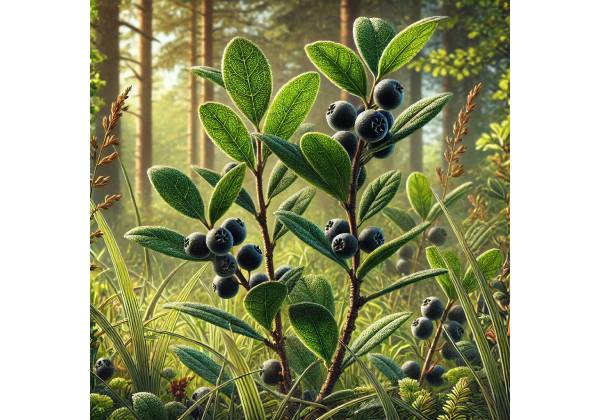Buckthorn refers to several shrubs and small trees in the Rhamnaceae family, frequently recognized for their thorny branches, small fruits, and a long history of varied uses. While there are many species commonly called “buckthorn,” the most referenced in herbal contexts include Rhamnus cathartica (common or European buckthorn) and Rhamnus frangula (alder buckthorn, sometimes reclassified as Frangula alnus). Depending on who you ask—wildlife ecologists, gardeners, or herbalists—buckthorn can be considered an invasive nuisance, a valuable source of dye, or a natural remedy with potential benefits for digestion and intestinal support.
In traditional settings, certain forms of buckthorn bark or berries were employed in folk medicine, primarily for their laxative and purgative qualities. Over time, extracts from this plant have found their way into commercial products aiming to address occasional constipation, or simply included in herbal formulas that promote cleansing. But as with many potent herbal items, some caution applies: the same compounds that can assist with bowel movements may cause cramping or discomfort if used improperly. Below, we’ll dive into every layer of the buckthorn story—from identification and ecology to phytochemistry, health potential, and responsible use.
- May function as a mild to moderate laxative support
- Contains anthraquinones that influence bowel activity
- Historically used in small amounts for intestinal cleansing
- Certain species yield strong dyes used in crafts
- Demands caution due to potential side effects and invasive spread
Table of Contents
- Buckthorn Botanical Profile and Identification Details
- Buckthorn’s Historical Context and Folklore
- Buckthorn Phytochemistry and Key Active Ingredients
- Buckthorn Health Advantages and Potential Roles
- Defining Buckthorn Properties That Set It Apart
- Buckthorn Uses, Applications, and Handling Safety
- Buckthorn Scientific Studies and Major Observations
- Buckthorn FAQ
Buckthorn Botanical Profile and Identification Details
Though multiple species bear the common name “buckthorn,” they share several general traits. They’re usually shrubby or small trees with oval leaves, small flowers, and distinctive berries that darken upon maturity. Understanding their main features—and telling them apart from similarly structured shrubs—can help you decide whether they’re a friend or foe in your local environment.
Physical Characteristics
- Leaves and Arrangement
- Many buckthorn species have simple, elliptical leaves, often with small, fine serrations along the edges. They typically appear glossy or slightly leathery, with prominent leaf veins.
- The leaf arrangement can be either alternate or sub-opposite, varying by species. For instance, common buckthorn often shows a sub-opposite pattern, making it somewhat unusual among shrubs.
- Buds and Twigs
- Twigs may carry a terminal spine or “thorn,” giving the plant its name. In older shrubs, side shoots may appear thorny as well.
- Winter buds on some species are small and dark, pressed close to the twig, which helps identify them outside the growing season.
- Flowers and Fruits
- Buckthorn flowers are typically small, inconspicuous, and grow in clusters along the branches. They can be greenish or white.
- Berries (drupes) form after pollination—starting green, then turning red, and finally becoming a deep purple or black once ripe. The berries often appear in groups and can persist into late fall.
- Bark
- The bark tends to be grayish to dark brown, sometimes developing shallow fissures or lenticels. On the inside, some buckthorn species display a distinctive yellowish or orange color in the cambium layer.
Geographic Range and Habitat
- European Buckthorn (Rhamnus cathartica)
Native to Europe, it has become invasive in North America, where it readily invades forests, wetlands, and disturbed sites. In some regions, it outcompetes native plants and forms dense thickets. - Alder Buckthorn (Rhamnus frangula or Frangula alnus)
Also of European origin, introduced in various parts of the world. It shares invasive tendencies in some climates but is also cultivated in certain gardens for ornamental reasons. - Cascara Buckthorn (Rhamnus purshiana)
Native to western North America, widely recognized in herbal circles for its bark used in over-the-counter laxative products. It thrives in moist forests from northern California into British Columbia.
Seasonal Cues
- Flowering Season
Depending on latitude, buckthorn may flower in late spring or early summer. The small, petal-like structures can be easy to miss if you’re not looking closely. - Berry Development
By mid to late summer, berries begin to form. They change color as they mature—usually fully ripening to a dark hue around early fall. - Leaf Drop
Species vary in leaf retention, but most will shed leaves in autumn. In invasive contexts, they sometimes hold onto leaves longer than native shrubs, giving them a competitive advantage.
Confusion with Other Shrubs
- Dogwood or Viburnum
Some dogwoods or viburnums also produce dark berries. Observing leaf venation, bud arrangement, and presence of thorns can help differentiate. Buckthorn leaves often have distinct, arching veins that stand out. - Black Cherry or Chokecherry
While these small trees also bear dark fruit, their bark and leaf shapes differ. Cherry species typically have distinct horizontal lenticels on bark, and the leaves come to a more pointed tip.
Spotting Invasiveness
- Dense Understory Growth
One hallmark of invasive buckthorn is thick stands crowding out native shrubs. If you see an area where nearly every shrub is the same species, forming an impenetrable thicket, it may well be buckthorn. - Early Leaf-Out
Many invasive buckthorns leaf out earlier in spring and keep leaves longer into fall, shading and outcompeting natives. This trait is particularly noticeable in forest understories.
Familiarizing yourself with these attributes can assist you in identifying whether the buckthorn in your yard or local park is an invasive species to remove or a beneficial ornamental you wish to keep. Because different species vary in their fruit color, time of fruiting, and the intensity of potential benefits or toxicity, correct identification is critical—especially if you’re interested in any possible herbal use.
Buckthorn’s Historical Context and Folklore
Buckthorn’s relationship with humans has been complex. On one hand, certain buckthorn species have caused ecological headaches. On the other, a subset has found a place in folk medicine for centuries. By looking at old herbal texts and regional traditions, we gain insight into why people once turned to buckthorn for specific needs—and how those uses continue (or fade) in modern times.
Roots in European Herbal Traditions
- Medieval and Renaissance Mentions
- Old herbals from Europe occasionally reference buckthorn bark or berries as cathartic agents, used to purge the body. In a time when humoral medicine stressed balancing bodily fluids, a strong purge was considered beneficial under certain circumstances.
- Individuals like Nicholas Culpeper, an English herbalist, might have mentioned it among purgatives, though caution was often advised due to its potency and side effects.
- Bark Harvesting
- Collecting bark from older trunks or branches was common, then drying it to reduce harshness. Some references insisted bark be stored for at least a year before usage to lessen its severe griping effect.
North American Interactions
- Invasive Introduction
- European buckthorn species were brought to North America as ornamental hedges or for windbreaks. Over time, they escaped gardens and spread aggressively, displacing native flora.
- Meanwhile, certain indigenous tribes recognized local buckthorn relatives and might have used them in minimal ways—though widespread usage is less documented compared to other medicinal shrubs.
- Cascara Sagrada
- The bark of Rhamnus purshiana, known as cascara sagrada (“sacred bark”), was discovered by European settlers to have strong laxative properties, a knowledge gleaned in part from indigenous use. It eventually became a commercial product in mainstream pharmacopeias.
Folklore and Symbolic Roles
- Protective or Magical Ties
Some old European legends mention buckthorn twigs warding off witches or evil spirits. This was mostly overshadowed by more commonly revered protective plants, but the occasional reference suggests a minor role in folk magic. - Colorful Dyes
Beyond medicinal aspects, the bark or unripe berries of certain buckthorn species can produce yellow, green, or brown dyes used for textiles. This function shows up in older local craft traditions throughout Europe.
Modernization and Commercialization
- Pharmaceutical Shifts
- By the late 19th century, official medicine recognized cascara sagrada bark (one type of buckthorn) and introduced it into commercial laxative products. Over time, standardized cascara-based formulas replaced home-brewed bark solutions.
- Meanwhile, the invasive European buckthorn species found themselves on “noxious weed” lists across many US states and Canadian provinces, forcing policy changes and control efforts.
- Contemporary Herbal Niche
- Some herbal suppliers still sell buckthorn bark (particularly from Rhamnus frangula, also known as alder buckthorn or “frangula bark”) for mild cathartic or cleansing formulas. However, the broader industry heavily relies on cascara or senna, overshadowing buckthorn bark.
- Ecological Tension
- Even though certain buckthorn species hold a medicinal pedigree, land managers and conservationists vigorously remove them from wild habitats to protect biodiversity. This tension exemplifies how a plant can be both a resource and a problem, depending on context.
Preserved Traditions in Local Circles
- Small-Scale Herbalists
In some rural or small-town communities, knowledge of how to prepare buckthorn bark (with extensive drying or aging to mellow out harsh effects) continues. Typically, older generations pass this on, though it’s less prevalent in modern holistic shops. - Crafters and Dyers
A niche group of artisans still harness buckthorn’s dye potential, especially for eco-friendly or historical reenactment textile methods. They might gather unripe berries or bark to yield earthy hues in wool or cotton.
Cultural Perception Today
Buckthorn is a polarizing presence: an ecological villain in certain habitats, but a minor hero in old-time remedies. Though overshadowed by safer, more thoroughly researched herbs, it persists in corners of folk tradition and specialized herbal practice. The future likely entails ongoing control efforts for invasive species and continued (though limited) usage in traditional or small-scale crafts. Understanding that complicated legacy helps anyone who approaches buckthorn—be it for horticulture, herbal exploration, or simple curiosity—grasp its full story and handle it responsibly.
Buckthorn Phytochemistry and Key Active Ingredients
Buckthorn’s bark, berries, and leaves carry a variety of compounds that can significantly affect their usage—whether in herbal formulas or raw forms. Chief among these are anthraquinones, which are recognized for their laxative properties, and other secondary metabolites that can range from mildly helpful to downright irritating if not used carefully.
Main Chemical Groups
- Anthraquinone Glycosides
- The bark and fruit of several buckthorn species—particularly alder buckthorn (Rhamnus frangula)—contain anthraquinone glycosides, known for their stimulant laxative action. These glycosides include compounds like frangulin and glucofrangulin.
- Similar to senna or cascara, these anthraquinones can speed intestinal transit time by stimulating peristalsis, which is why buckthorn once found usage in constipation relief.
- Tannins
- Tannins can impart an astringent property, giving the bark a somewhat bitter or puckering taste. In lower doses, tannins may help tone tissues; in higher doses, they could irritate the stomach or intestines.
- Flavonoids
- Trace amounts of flavonoids might occur in buckthorn’s leaves and fruits. These compounds often exhibit antioxidant or anti-inflammatory potential, though the overall concentration can be modest.
- Phenolic Acids
- Additional phenolic substances, like caffeic or chlorogenic acid derivatives, might appear in small quantities. While not typically the star of buckthorn’s properties, they could contribute subtle protective effects.
Bark vs. Berry Composition
- Bark
The bark is typically the main medicinal part, dried and aged to reduce harshness. Aging or heat treatment can help convert certain glycosides into milder forms. - Berries
The fruits contain anthraquinones as well but can be more unpredictable. Overconsumption of raw berries can lead to severe digestive upset. Some older dye recipes rely on these berries, leveraging anthraquinone derivatives for color.
Influences on Toxicity
- Fresh vs. Processed
- Uncured or fresh bark typically contains higher levels of free anthrones, which are quite potent irritants. Proper drying and storage (often at least a year) can transform them into less reactive glycosides.
- This transformation is essential to moderate the plant’s harsh griping effects.
- Dose and Duration
- The main difference between a mild laxative effect and a painful purge or potential toxicity often comes down to dosage. Repeated or large doses can disrupt electrolyte balance or damage the intestinal lining.
- Potential for Hypersensitivity
- Some individuals might react strongly to anthraquinones, even at relatively low amounts. Observing for signs of cramping or diarrhea is important.
Comparisons to Other Laxative Herbs
- Senna or Cascara
Like senna or cascara, buckthorn harnesses anthraquinones for its bowel-stimulating effect. However, senna and cascara are more heavily researched and regulated in many countries, leading to standardized extracts with predictable potency. Buckthorn remains less standardized overall. - Rhubarb Root
Another anthraquinone-bearing herb, rhubarb root (the medicinal kind, not the culinary stems) has a similar property set, though each plant’s ratio of anthraquinones can differ, influencing the side-effect profile.
Additional Minor Compounds
- Essential Oils
- Some references mention that buckthorn bark contains minimal essential oil or terpene traces. The actual effect is overshadowed by the anthraquinone presence.
- Minerals
- The bark can contain trace minerals from the soil, but these seldom appear in high enough levels to be nutritionally relevant.
Safety Mechanisms in the Plant
- Deterrent Function
The fact that anthraquinones produce a purgative effect in large mammals might actually help the plant by discouraging overconsumption of its fruit or bark by herbivores. This advantage underscores how plants naturally evolve chemical defenses.
Implications for Herbal Use
- Need for Proper Processing
Because anthraquinones can degrade from harsh or toxic forms into gentler forms over time, any legitimate use of buckthorn bark demands correct preparation and aging. Using raw bark is discouraged. - Potential Microbial Effects
Some anthraquinones exhibit mild antimicrobial or antifungal action. While interesting in lab settings, it’s not widely exploited in medical or cosmetic industries, overshadowed by safer alternatives.
In conclusion, buckthorn’s chemical load of anthraquinones and other constituents underscores why it’s revered as a potent laxative—and simultaneously flagged as potentially risky. Understanding that interplay of anthraquinones, tannins, and minimal flavonoids clarifies the importance of caution and respect for proper dosage. That’s why legitimate herbal references typically stress “processed buckthorn bark only” and disclaimers on usage duration, ensuring any beneficial effect doesn’t cross the line into harm.
Buckthorn Health Advantages and Potential Roles
Throughout folk medicine, buckthorn bark (especially from alder buckthorn or common buckthorn) has featured in purgative formulas. The purported health perks revolve mostly around clearing the bowel or aiding mild detox. However, verifying these benefits with modern science is a trickier path. Below, we detail the main claims about buckthorn in the context of health and wellness.
1. Intestinal Cleansing and Occasional Constipation Relief
- Mild to Moderate Laxative
Thanks to its anthraquinones, buckthorn can stimulate the colon, promoting bowel movements. This effect can help those who experience infrequent or sluggish elimination. - Many herbal references point to short-term usage only, as prolonged reliance on anthraquinone laxatives may hamper the gut’s natural motility.
- Potential Alternative to Senna or Cascara
Some enthusiasts prefer buckthorn if they find senna or cascara too harsh. However, the difference is subtle—buckthorn still can cause cramps if used excessively or incorrectly.
2. Detox and Bowel Regularity
- System “Reset”
Proponents of “internal cleansing” sometimes incorporate buckthorn bark in gentle formula blends. The rationale: assisting the body’s elimination pathways, helping rid the colon of waste buildup. - While the concept of “detoxing” is debated by many health professionals, anecdotal feedback from mild, occasional usage persists.
- Pairing with Soothing Herbs
Because buckthorn can induce gripping or cramping, it’s often combined with demulcent or carminative herbs—like licorice root, fennel, or chamomile—to calm the gut. This synergy can reduce side effects.
3. Historical Use in Liver and Gallbladder Tonic
- Folk Mentions
In older texts, small doses of buckthorn might have been recommended to spur bile flow or help with certain digestive sluggishness. This is less common in modern practice due to more refined approaches or other, safer cholagogues (like dandelion or artichoke extracts). - Lack of Contemporary Validation
Very few modern studies confirm any direct hepatic benefit. So, if you’re seeking a dedicated liver support herb, buckthorn isn’t typically top-tier.
4. Skin or External Applications
- Occasional Wash or Poultice
Some herbal traditions describe the bark steeped in warm water to create a mild external wash for certain skin issues. The rationale might connect to the bark’s slight antimicrobial or astringent properties. - This use remains anecdotal, overshadowed by more recognized external herbs.
5. Potential Anti-Inflammatory or Antioxidant Activity
- Anthraquinones in a Broader Sense
Although anthraquinones can exhibit anti-inflammatory potential in lab settings, the same compounds in high amounts also irritate tissues. This contradictory nature implies that buckthorn usage for anti-inflammatory goals is extremely limited. - Polyphenol Presence
Minor flavonoids or phenolic acids might provide mild antioxidant effects, but it’s not an especially potent antioxidant source compared to foods like berries or green tea.
6. Blood Sugar or Lipid Management?
- Rumors vs. Evidence
Occasionally, you’ll find claims that a buckthorn-based remedy can help with glucose regulation or cholesterol. Peer-reviewed research is scant. If any effect exists, it’s not well studied or widely recognized.
7. Menstrual or Hormonal Balancing
- Older Remedies
A few references from archaic herbals mention using small amounts of buckthorn bark to encourage menstrual flow or “clear the womb.” This usage was typically overshadowed by potential side effects. - Lack of Modern Support
Today, other herbs (like ginger, raspberry leaf, or motherwort) are more commonly recommended for gently supporting menstrual health. There’s no significant endorsement for buckthorn in this realm.
8. Weight Management or Slimming Teas
- Diuretic and Laxative Effects
Because of its capacity to reduce water retention or prompt bowel movements, buckthorn sometimes sneaks into “slimming teas.” However, this is mostly water weight or short-term relief, not genuine fat loss. - Cautions
Overreliance on laxatives for weight control is hazardous, risking nutrient malabsorption and dependence. Credible health advice typically discourages such an approach.
Summary of Potential Buckthorn Benefits
- Primary Role: Occasional relief of constipation or bowel sluggishness, usually in carefully measured short-term doses.
- Secondary or Adjunct: Rarely, mild external use or minimal presence in some “detox” formulas, though overshadowed by safer herbs.
- The Bottom Line: Like other anthraquinone-based plants, it can be beneficial if used properly—yet misuse can lead to significant gastrointestinal distress or more severe issues.
Given that recognized medical experts emphasize caution with anthraquinone-based laxatives, it’s crucial to weigh any possible advantage of buckthorn against the risk of cramping, dependency, or damage to the intestinal lining. If a gentle, less risky option suits your needs, you may want to consider other well-established solutions (such as dietary fiber or milder herbs) unless specifically guided by an experienced herbal practitioner.
Defining Buckthorn Properties That Set It Apart
Buckthorn might not be as famous as certain other herbal mainstays, but it has some unique attributes that shape how people interact with it—whether that’s in a yard, in herbal blends, or on nature trails. These properties reflect both the practical and ecological dimensions of this sometimes-controversial plant.
1. Strong Laxative Potential
- Anthraquinone Influence
The presence of anthraquinones in buckthorn bark marks it as potentially more forceful than simple bulk-forming laxatives like psyllium. This can be a double-edged sword: beneficial in short bursts, troublesome if overused. - Time-Dependent Conversion
Buckthorn bark typically needs aging (about a year or so) to mitigate harsh anthrone components. This aging process stands out from many other herbs that you can use fresh or simply air-dry for a few weeks.
2. Invasive Tendency in Some Species
- Rapid Spread
European buckthorn (Rhamnus cathartica) is notorious for colonizing forests, wetlands, and disturbed soils in North America. Its seeds are widely dispersed by birds that feed on the berries (though the berries can cause digestive upset in the birds themselves). - Year-Round Advantage
These shrubs or small trees tend to leaf out early and hold leaves late into autumn, shading out competitors. This trait underscores their capacity to disrupt local ecosystems, overshadowing any herbal significance.
3. Unusual Berry and Bark Dye
- Natural Dye Source
Historically, unripe buckthorn berries and bark produced greenish-yellow or brown dyes. While not as widely used as woad or indigo, it provided a local color resource in some European crafts. - Color Variation
The color can shift based on the part used, pH levels, and mordants. This property has mild modern interest among natural dye enthusiasts seeking historical or eco-friendly alternatives.
4. Ornamental Value vs. Detriment
- Somewhat Attractive Foliage
If pruned properly, certain buckthorn shrubs present a dense green look that might appeal to private hedge owners. Historically, that’s how many invasive species were introduced—people liked their screening effect or glossy leaves. - Costly Environmental Management
Because the shrubs can escape cultivation, local governments or nonprofits often spend considerable resources removing them from natural reserves. The tension between ornamental usage and invasive status is a prime reason many horticultural societies discourage planting them.
5. Bark Texture and Color
- Identifiable Inner Bark
Some species have distinctive bright orange to yellowish inner bark. This can aid in identification. If collecting for herbal reasons, the bark is often peeled from branches, but such harvest can harm the plant if done improperly. - Age-Linked Changes
Younger plants have smooth bark, often grayish, while older trunks develop rougher ridges or fissures. This incremental shift is common among many shrubs, but the buckthorn’s bark can reveal a noticeable color distinction when peeled.
6. Intersection of Toxicity and Utility
- No Edible Berries
Many common shrubs produce edible fruit, but buckthorn’s are widely recognized as inedible or poisonous. This sets it apart from, say, elderberry or hawthorn, which share the “thorny berry-bearing bush” vibe but are used for jam or wine. - Small Window of Medicinal Utility
The parted line between a beneficial dose and a harmful one is narrower than in many mild herbs. This dynamic shapes a cautious approach among herbalists who handle buckthorn bark for specific laxative formulas.
7. Cultural Myths and Perceptions
- “Cathartic or Curse?”
Because of strong purgative power, older references used hyperbole to describe buckthorn’s “fierce grip.” This gave it a somewhat fearsome reputation, overshadowing gentler uses it might have had. - Mythic or Magical Mentions
Certain local legends might label the black berries as a sign of ill omen or connect them to witches’ brews. These are more whimsical than widely believed, but they highlight how the plant’s strong effect can inspire tall tales.
8. Emergence of Hybrid or Ornamental Varieties
- “Cultivar Buckthorn”
Some horticulturists experiment with crossing buckthorn species to reduce fruiting or thorniness, hoping to keep ornamental appeal minus the invasive seeding. Success is mixed, and these cultivars remain uncommon, overshadowed by the negative press around invasiveness.
All in all, buckthorn’s identity is shaped by potent anthraquinones, a formidable invasive streak, and a historical track record as a strong (and sometimes harsh) herbal remedy. Whether you see it as a noxious weed, a quick-fix laxative, or a resource for natural dyes, buckthorn stands apart from everyday shrubs with a distinctive synergy of biology, chemistry, and cultural narrative.
Buckthorn Uses, Applications, and Handling Safety
Given its strong natural properties, buckthorn is not a casual plant to incorporate into your routine without some research. While it’s recognized for its potential as a stimulant laxative, it carries enough risk to warrant careful practice—or avoidance altogether if safer alternatives are at hand. Below we’ll explore typical uses, plus tips to handle it responsibly.
1. Herbal Laxative or Cleansing Formulas
- Bark Preparations
- Dried, aged bark from certain buckthorn species (like alder buckthorn) can be used in small amounts for short-term relief of occasional constipation. Herbal references often indicate a 6–12 months curing period to reduce harsh anthrones.
- Teas, capsules, or powders might appear in specialized shops, typically labeled as “Frangula bark” or “Rhamnus frangula.” The recommended dose is conservative (and usage typically no more than 1–2 weeks).
- Concerns of Overuse
- Over-reliance can cause watery stools, dehydration, or even dependency. Anthraquinone-based laxatives are best reserved for short-term usage with professional guidance.
2. Occasional External or Dyeing Purposes
- Dye Crafts
Gathering unripe berries or bark to produce natural pigments (greens or browns) is a niche but legitimate use. Proper technique involves simmering the plant material in water, then using a mordant to fix color on fibers. - Minor Topical Practices
Some minor references mention washing minor skin issues with a diluted bark infusion. If tried, test on a small area because of possible irritant effects. This is not widely mainstreamed in herbal practice.
3. Ecological or Ornamental Roles (with Caution)
- Screening or Hedge
- Historically, buckthorn was planted as a hedge or windbreak. Because of invasive tendencies, many horticultural societies now discourage new plantings of species like Rhamnus cathartica.
- If you do want a buckthorn hedge, look for non-invasive or sterile cultivars—though availability is limited.
- Nature Observations
- If you own woodland with buckthorn infestation, understand that controlling it might be beneficial for native biodiversity. Mechanical removal or prudent chemical approaches can halt spread, though repeated management is often necessary.
4. Potential Combinations and Synergy
- With Soothing Herbs
If using buckthorn bark for constipation, many herbal formulas add fennel, peppermint, or licorice to reduce cramps. This synergy aims to offset the intensities of anthraquinone action. - Balancing Electrolytes
Because stimulant laxatives can lead to fluid or mineral loss, some people pair usage with electrolyte-rich beverages or gentle rehydration solutions. This precaution helps maintain bodily balance.
5. Proper Sourcing and Identification
- Commercial Products
- If you’re purchasing a buckthorn-based item, confirm it’s from a reputable brand. The label should specify species (like Frangula alnus) and disclaim recommended dosage.
- Beware of cheap or unvetted sources online, as improper bark processing can cause excessive harshness or toxicity.
- Wild Harvesting
- Harvesting bark from wild trees is not recommended if you lack experience. Overharvesting can kill or severely damage the shrub, and you risk misidentification with other species.
- Always confirm it’s not a protected area or a location where the species is being actively removed for ecosystem reasons.
6. Potential Side Effects and Toxicity
- Cramping and Diarrhea
- The most immediate side effect is abdominal cramping, watery stools, or even diarrhea if the dose is too high. This effect can come on swiftly given anthraquinone potency.
- Electrolyte Imbalance
- Chronic or overuse can cause low potassium, triggering weakness, heart rhythm issues, or general lethargy—mirroring concerns with other stimulant laxatives.
- Allergic Reactions
- Rarely, some individuals might develop allergic responses. Discontinue and consult medical assistance if you observe rash, breathing difficulty, or other serious signs.
- Medication Interactions
- Because buckthorn can speed up transit time in the gut, it may reduce absorption of oral medications if taken simultaneously. Consult a healthcare provider about spacing if you rely on consistent medication levels.
7. Special Populations and Warnings
- Pregnant or Nursing Individuals
The intense nature of buckthorn suggests it’s not advisable for pregnancy or breastfeeding. The last thing recommended is a potent purgative effect or potential toxic exposure for mother or child. - Children’s Use
Pediatric usage is discouraged, as the line between a safe mild dose and an overbearing one is slim, and children’s systems can be more sensitive. - Chronic GI Conditions
If someone has conditions like Crohn’s disease, ulcerative colitis, or IBS, using anthraquinone-based herbs might aggravate them. Always approach with professional input.
8. Duration and Dosing Recommendations
- Short-Term Only
- Reputable herbal sources often recommend using buckthorn bark for no more than 1–2 weeks without medical supervision. Prolonged use can lead to “lazy bowel” or other complications.
- Low-Start Approach
- Starting with a minimal recommended dose can help gauge personal sensitivity. If cramping or discomfort is minimal, you can find a comfortable threshold.
Ultimately, buckthorn can offer a real effect on bowel movements—this is not mere anecdote. Yet that potency also spells caution. Many herbalists now favor gentler solutions or better-researched anthraquinone sources like senna or cascara, which come with established guidelines and standardization. If buckthorn remains your choice—perhaps due to tradition or personal preference—ensure you handle it responsibly, focusing on modest amounts, short durations, and well-documented sources. Balanced usage can harness the bark’s potential without unleashing its more disruptive side.
Buckthorn Scientific Studies and Major Observations
Among the anthraquinone-bearing plants, buckthorn sits in the shadow of better-studied relatives like senna or cascara sagrada. Still, a scattering of research and historical references sheds light on its chemical profile and effects. While no large-scale modern trials exist to thoroughly confirm its health claims, these smaller investigations and historical notes remain instructive.
1. Early Pharmacopoeias
- European Herbal Lore
Medieval and Renaissance texts mention “Rhamnus” bark as a purgative, emphasizing caution. By the 19th century, references in American and European pharmacopeias listed buckthorn bark for occasional constipation. They uniformly warned about violent purging if misused. - Lewis and Clark Era
Anecdotal historical records from early American expeditions or settler diaries mention the strong effect of “buckthorn bark tea,” often describing its taste as bitter and results as dramatic.
2. Comparative Phytochemical Analyses
- Anthraquinone Levels
In a 1970s lab analysis from a German phytochemistry journal, researchers measured anthraquinone glycosides in various species of Rhamnus. They found that drying and aging the bark significantly lowered free anthrone content, confirming that fresh bark is more irritating. - Saponin and Tannin Studies
Some smaller studies looked at the saponins or tannins in buckthorn fruit, concluding their presence but lacking thorough exploration into medical or nutritional benefits.
3. Laxative Efficacy Investigations
- Small Observational Trials
A few mid-20th-century attempts tested buckthorn bark extracts on volunteer groups suffering mild constipation. While results indicated short-term relief, side effects like cramping or looser-than-desired stools limited the approach. - No modern, large randomized controlled trials (RCTs) replicate these early tests, making them historically informative but not conclusive for today’s standards.
- Safety Concerns
Notably, repeated mentions of potential for “bowel dependency” and electrolyte imbalance arose in these older studies, paralleling warnings for other anthraquinone-based solutions.
4. Toxicity Case Reports
- Livestock Poisoning
Veterinary records occasionally document cattle or horse poisoning after ingesting significant amounts of buckthorn leaves or berries. Symptoms include drooling, weakness, and severe diarrhea. - While not human studies, these instances underscore the potent toxins in the plant, reaffirming that it’s far from benign.
- Human Overdose Incidents
Officially reported cases are minimal, likely because buckthorn is less commonly used than, say, senna or horse chestnut. Those that do exist revolve around GI distress and dehydration from over-laxative use.
5. Potential Environmental Impact
- Invasive Ecology
More research has examined buckthorn’s ecological impact than its medicinal aspects. Multiple field studies confirm how Rhamnus cathartica disrupts native plant communities, fosters nitrate leaching in soils, and influences local insect populations. - Seed Dispersal
Ornithologists have noted that birds eat buckthorn berries but can experience mild laxative effects that quickly spread seeds across distances. This phenomenon partly explains the invasive success documented by ecological bulletins.
6. Modern Herbalist Perspectives
- Limited Mentions in Updated References
In contemporary herbal compendiums, buckthorn is overshadowed by cascara or senna, both better studied. Mentions are brief: “An older anthraquinone-based herb with strong purgative properties, recommended only under caution or for short stints.” - Organic Chemistry Interest
Some anthraquinones found in buckthorn might interest organic chemists for potential synthetic derivatives, but practical application in mainstream pharmaceuticals hasn’t materialized.
Buckthorn FAQ
Is buckthorn safe to eat if I remove the seeds or cook it?
Generally no. Buckthorn berries and bark contain anthraquinones and other toxins that are not neutralized just by boiling or removing seeds. Even after certain processes, it can still be quite harsh on the digestive system. Consuming raw or minimally treated buckthorn can lead to significant stomach upset or worse.
How can I tell if the buckthorn in my yard is invasive or a beneficial variety?
Common or European buckthorn (Rhamnus cathartica) and glossy buckthorn (Frangula alnus) are widely labeled invasive in North America. They often crowd out native shrubs, have dark purple to black berries, and form dense thickets. If you’re unsure, contacting a local extension office for identification or confirmation is a good step.
Can I use buckthorn bark for a homemade laxative safely?
Most herbal references strongly advise caution. If incorrectly processed or used at high doses, buckthorn bark can cause severe cramping, diarrhea, and potential dependency. It’s better to rely on well-researched anthraquinone-based herbs (like cascara or senna) that are standardized, or simpler alternatives like psyllium. Seek professional guidance first.
Is there a recommended method to get rid of invasive buckthorn on my property?
Yes, but it can be challenging. Strategies often include cutting and properly disposing of the shrubs, applying targeted herbicides to stumps, or consistent monitoring for regrowth. Consult local environmental guidelines—some communities offer buckthorn removal programs or specific tips for your region.
Disclaimer
The information provided here is intended for educational purposes only and is not a replacement for professional medical advice. Always consult a qualified healthcare provider or conservation expert for decisions regarding buckthorn usage, removal, or health-related matters.
If you found this deep dive into Buckthorn useful, please consider sharing it on Facebook, X (formerly Twitter), or other social channels. Spreading knowledge can help others learn about this intriguing yet sometimes problematic plant and how to handle it responsibly!

















